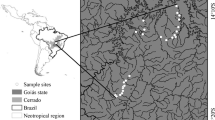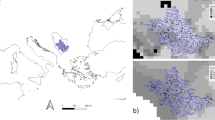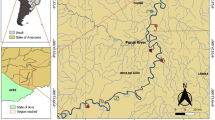Abstract
In the last three decades, several studies have suggested that the structure of stream macroalgal communities is shaped by local environmental variables, but some recent papers have shown that the relevance of the environment on these communities may be overestimated. Using Partial Redundancy Analysis (pRDA), we analyzed macroalgal communities (considering all macroalgae and Phyla Chlorophyta, Cyanobacteria, and Rhodophyta individually) from 105 streams in southern Brazil to test the hypothesis that the relative contributions of the environment and space on the taxonomic composition of these communities is mainly determined by the biological traits and dispersal mechanisms typical for each group. The pRDA showed that the taxonomic composition of the entire community and green algae were explained by both space and environment, whereas for cyanobacteria, only the environment was significant, and for red algae, only space was significant. These divergences in the relative contribution among algal phyla were consistent with our initial hypothesis and can be ascribed to the differences in the ecological features of each group. Our results also support the idea that the community structure of organisms with low dispersal is influenced more significantly by spatial processes, whereas for organisms with high dispersal the local environmental variables are more influential.


Similar content being viewed by others
References
Algarte, V. M., L. Rodrigues, V. L. Landeiro, T. Siqueira & L. M. Bini, 2014. Variance partitioning of deconstructed periphyton communities: does the use of biological traits matter? Hydrobiologia 722: 279–290.
Azaele, S., R. Muneepeerakul, A. Maritan, A. Rinaldo & I. Rodriguez-Iturbe, 2009. Predicting spatial similarity of freshwater fish biodiversity. Proceedings of the National Academy of Sciences of the United States of America 106: 7058–7062.
Beisner, B. E., P. R. Peres-Neto, E. S. Lindström, A. Barnett & M. L. Longhi, 2006. The role of environmental and spatial processes in structuring lake communities from bacteria to fish. Ecology 87: 2985–2991.
Blanchet, F. G., P. Legendre & D. Borcard, 2008. Forward selection of explanatory variables. Ecology 89: 2623–2632.
Borcard, D. & P. Legendre, 2002. All-scale spatial analysis of ecological data by means of principal coordinates of neighbour matrices. Ecological Modelling 153: 51–68.
Borcard, D., P. Legendre & P. Drapeau, 1992. Partialling out the spatial component of ecological variation. Ecology 73: 1045–1055.
Bojorge-García, M., J. Carmona, Y. Beltrán & M. Cartajena, 2010. Temporal and spatial distribution of macroalgal communities of mountain streams in Valle Bravo Basin, central Mexico. Hydrobiologia 641: 159–169.
Branco, C. C. Z. & O. Necchi Júnior, 1996. Distribution of stream macroalgae in the eastern Atlantic Rainforest of São Paulo State, sotheastern Brazil. Algological Studies 333: 139–150.
Branco, C. C. Z., L. H. Z. Branco, M. O. Moura & F. R. Bertusso, 2005. The succession dynamics of a macroalgal community after a flood disturbance in a tropical stream from São Paulo State, Southeastern Brasil. Brazilian Journal of Botany 28: 267–275.
Branco, C. C. Z., R. A. Krupek & C. K. Peres, 2009. Distribution of stream macroalgal communities from the mid-western region of Paraná State, southern Brazil: importance of local-scale variation. Brazilian Archives of Biology and Technology 52: 379–386.
Brown, B. L., C. M. Swan, D. A. Auerbach, E. H. Campbell Grant, N. P. Hitt, K. O. Maloney & C. Patrick, 2011. Metacommunity theory as a multispecies, multiscale framework for studying the influence of river network structure on riverine communities and ecosystems. Journal of the North American Benthological Society 30: 310–327.
Convertino, M., R. Muneepeerakul, S. Azaele, E. Bertuzzo, A. Maritan, A. Rinaldo & I. Rodriguez-Iturbe, 2009. On neutral metacommunity patterns of river basins at different scales of aggregation. Water Resources Research 45: 1–15.
Cottenie, K., 2005. Integrating environmental and spatial processes in ecological community dynamics. Ecology Letters 8: 1175–1182.
Coutinho, L. M., 2006. O conceito de bioma. Acta Botanica Brasilica 20: 13–23.
De Bie, T., L. De Meester, L. Brendonck, K. Martens, B. Goddeeris, D. Ercken, H. Hampel, L. Denys, L. Vanhecke, K. Van der Gucht, J. Van Wichelen, W. Vyverman & S. A. J. Declerck, 2012. Body size and dispersal mode as key traits determining metacommunity structure of aquatic organisms. Ecology Letters 15: 740–747.
Dell’Uomo, A., 1991. Use of benthic macroalgae for monitoring rivers in Italy. In Whitton, B. A., E. Rott & G. Friedrich (eds), Use of Algae for Monitoring Rivers. Institut für Botanik, Universität Innsbruck, Innsbruck: 129–138.
DeNicola, D. M., K. D. Hoagland & S. C. Roemer, 1992. Influences of canopy cover on spectral irradiance and periphyton assemblages in a prairie stream. Journal of the North American Benthological Society 11: 391–404.
Drakare, S. & A. Liess, 2010. Local factors control the community composition of cyanobacteria in lakes while heterotrophic bacteria follow a neutral model. Freshwater Biology 55: 2447–2457.
Dray, S., P. Legendre & G. Blanchet, 2009. packfor: Forward Selection with permutation (Canoco p.46). R package version 0.0-7/r58. http://R-Forge.R-project.org/projects/sedar/.
Fierer, N., J. L. Morse, S. T. Berthrong, E. S. Bernhardt & R. B. Jackson, 2007. Environmental controls on the landscape-scale biogeography of stream bacterial communities. Ecology 88: 2162–2173.
Gordon, N. D., T. A. McMahon & B. L. Finlayson, 1992. Stream Hydrology, an Introduction for Ecologists. Wiley, Chichester.
Göthe, E., D. G. Angeler & L. Sandin, 2013. Metacommuniy structure in a small boreal stream network. Journal of Animal Ecology 82: 449–458.
Heino, J. & H. Mykrä, 2008. Control of stream insect assemblages: roles of spatial configuration and local environmental factors. Ecological Entomology 33: 614–622.
Hepp, L. U. & A. S. Melo, 2013. Dissimilarity of stream insect assemblages: effects of multiple scales and spatial distances. Hydrobiologia 703: 239–246.
Hitt, N. P. & P. L. Angermeier, 2011. Fish community and bioassessment response to stream network position. Journal of the North American Benthological Society 30: 296–309.
Hu, B. F. & S. L. Xie, 2006. Effect of seasonality on distribution of macroalgae in a stream system (Xinàn Spring) in Shanxi Province, North China. Journal of Integrative Plant Biology 48: 889–896.
Kristiansen, J., 1996. Dispersal of freshwater algae – a review. Hydrobiologia 336: 151–157.
Landeiro, V. L., L. M. Bini, A. S. Melo, A. M. O. Pes & W. E. Magnusson, 2012. The roles of dispersal limitation and environmental conditions in controlling caddisfly (Trichoptera) assemblages. Freshwater Biology 57: 1554–1564.
Legendre, P. & L. Legendre, 1998. Numerical Ecology. Elsevier Science, Amsterdam.
Legendre, P., D. Borcard, G. Blanchet & S. Dray, 2010. PCNM: PCNM spatial eigenfunction and principal coordinate analyses. R package version 2.1/r82. http://R-Forge.R-project.org/projects/sedar/.
Leibold, M. A. M., M. Holyoak, N. Mouquet, P. Amarasekare, J. M. Chase, M. F. Hoopes, R. D. Holt, J. B. Shurin, R. Law, D. Tilman, M. Loreau & A. Gonzalez, 2004. The metacommunity concept: a framework for multi-scale community ecology. Ecology Letters 7: 601–613.
Logue, J. B., N. Mouquet, H. Peter, H. Hillebrand, P. Declerck, A. Flohre, S. Gantner, N. Gülzow, P. Hörtnagl, S. Meier & B. Pecceu, 2011. Empirical approaches to metacommunities: a review and comparison with theory. Trends in Ecology and Evolution 26: 482–491.
Muneepeerakul, R., J. S. Weitz, S. A. Levin, A. Rinaldo & I. Rodriguez-Iturbe, 2007. A neutral metapopulation model of biodiversity in river networks. Journal of Theoretical Biology 245: 351–363.
Muneepeerakul, R., E. Bertuzzo, H. J. Lynch, W. F. Fagan, A. Rinaldo & I. Rodriguez-Iturbe, 2008. Neutral metacommunity models predict fish diversity patterns in Mississippi-Missouri basin. Nature 453: 220–222.
Nabout, J. C., T. Siqueira, L. M. Bini & I. S. Nogueira, 2009. No evidence for environmental and spatial processes in structuring phytoplankton communities. Acta Oecologica 35: 720–726.
Necchi Júnior, O., C. C. Z. Branco, R. C. G. Simões & L. H. Z. Branco, 1995. Distribution of stream macroalgae in northwest region of São Paulo State, Southern Brazil. Hydrobiologia 299: 219–230.
Necchi Júnior, O., C. C. Z. Branco & L. H. Z. Branco, 2000. Distribution of stream macroalgae in São Paulo State, southeastern Brazil. Algological Studies 97: 43–57.
Ng, I. S. Y., C. M. Carr & K. Cottenie, 2009. Hierarchical zooplankton metacommunities: distinguishing between high and limiting dispersal mechanisms. Hydrobiologia 619: 133–143.
Oksanen, J., F. Blanchet, H. Kindt, P. Legendre, P. R. Minchin, R. B. O’Hara, G. L. Simpson, P. Solymos, M. Henry, H. Stevens & H. Wagner, 2011. vegan: Community Ecology Package. R package version 2.0-0. http://CRAN.R-project.org/package=vegan.
Okuda, T., T. Noda, T. Yamamoto, M. Hori & M. Nakaoka, 2010. Contribution of environmental and spatial processes to rocky intertidal metacommunity structure. Acta Oecologica 36: 413–422.
Padisák, J., 2004. Phytoplankton. In O’Sullivan, P. E. & C. S. Reinolds (eds), The Lakes Handbook 1. Limnology and Limnetic Ecology. Blackwell Science Ltd., Oxford: 251–308.
Pandit, S. N., J. Kolasa & K. Cottenie, 2009. Contrast between habitat generalists and specialists: an empirical extension to the basic metacommunity framework. Ecology 90: 2253–2262.
Patrick, C. J. & C. M. Swan, 2011. Reconstructing the assembly of a stream-insect metacommunity. Journal of the North American Benthological Society 30: 259–272.
Peres-Neto, P. R., P. Legendre, S. Dray & D. Borcard, 2006. Variation partitioning of species data matrices: estimation and comparison of fractions. Ecology 87: 2614–2625.
Potts, M., 1999. Mechanisms of desiccation tolerance in cyanobacteria. European Journal of Phycology 34: 319–328.
R Development Core Team, 2011. R: a language and environment for statistical computing. R Foundation for Statistical Computing, Vienna. http://www.R-project.org.
Schulz, G., T. Siqueira, G. Stefan & F. O. Roque, 2012. Passive and active dispersers respond similarly to environmental and spatial processes: an example from metacommunity dynamics of tree hole invertebrates. Fundamental and Applied Limnology 181: 315–326.
Sheath, R. G. & J. M. Burkholder, 1985. Characteristics of softwater streams in Rhode Island. II. Composition and seasonal dynamics of macroalgal communities. Hydrobiologia 140: 183–191.
Sheath, R. G. & K. M. Cole, 1992. Biogeography of stream macroalgae in North America. Journal of Phycology 28: 448–460.
Sheath, R. G. & J. A. Hambrook, 1990. Freshwater ecology. In Cole, K. M. & R. G. Sheath (eds), Biology of the Red Algae. Cambridge University Press, Cambridge: 423–453.
Siqueira, T., L. M. Bini, F. O. Roque, S. R. M. Couceiro, S. Trivinho-Strixino & K. Cottenie, 2012. Common and rare species respond to similar niche processes in macroinvertebrate metacommunities. Ecography 35: 183–192.
Soininen, J., R. McDonald & H. Hillebrand, 2007. The distance decay of similarity in ecological communities. Ecography 30: 3–12.
Swan, C. M. & B. L. Brown, 2011. Advancing theory of community assembly in spatially structured environments: local vs regional processes in river networks. Journal of the North American Benthological Society 30: 232–234.
Verb, R. G. & M. L. Vis, 2001. Macroalgal communities from an acid mine drainage impacted watershed. Aquatic Botany 71: 93–107.
Verreydt, D., L. De Meester, E. Decaestecker, M. J. Villena, K. Van Der Gucht, P. Vannormelingen, W. Vyverman & S. A. J. Declerck, 2012. Dispersal-mediated trophic interactions can generate apparent patterns of dispersal limitation in aquatic metacommunities. Ecology Letters 15: 218–226.
Acknowledgments
We are grateful to FAPESP for financial support (proc. 2007/52608-1), a doctoral scholarship to AFT (proc. 2010/17563-0) and language revision (proc. 2012/201196-8), to CNPq for a doctoral scholarship to CKP (proc. 141754/2007-9) and research grants to CCZB (proc. 302354/2008-5), LHZB (proc. 301400/2009-1) and PCB (proc. 307577/2011-2). We also thank ICMBio/MMA and the conservation units for granting permission to collect specimens and for providing logistical support during field work.
Author information
Authors and Affiliations
Corresponding author
Additional information
Handling editor: Luis Mauricio Bini
Rights and permissions
About this article
Cite this article
Branco, C.C.Z., Bispo, P.C., Peres, C.K. et al. The roles of environmental conditions and spatial factors in controlling stream macroalgal communities. Hydrobiologia 732, 123–132 (2014). https://doi.org/10.1007/s10750-014-1852-2
Received:
Revised:
Accepted:
Published:
Issue Date:
DOI: https://doi.org/10.1007/s10750-014-1852-2




